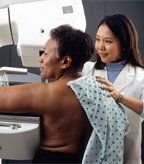ASCO: Frequent Genetic Mutations in Black Women With Breast Cancer
A single-center study analyzed the frequency of breast cancer susceptibility mutations among black women diagnosed with breast cancer. The findings suggest that broader genetic screening may be beneficial for these women. The study also suggests that family history is not the only criteria by which patients at risk for breast cancer can be identified.
CHICAGO-A single-center study analyzed the frequency of breast cancer susceptibility mutations among black women diagnosed with breast cancer. The findings suggest that broader genetic screening may be beneficial for these women. The study also suggests that family history is not the only criteria by which patients at risk for breast cancer can be identified.

The University of Chicago study sequenced 18 breast cancer susceptibility genes from 249 black women who were diagnosed with breast cancer and who were referred to genetic counseling at the Cancer Risk Clinic at the University of Chicago.
The researchers used targeted genomic capture and next-generation sequencing to capture mutations in the 18 genes selected, a test they call “BROCA.” Only mutations previously identified as clinically relevant, loss-of-function mutations, were included in the analysis.
Jane E. Churpek, MD, assistant professor of medicine at the University of Chicago, presented the data at the annual meeting of the American Society of Clinical Oncology (ASCO), showing 22% (56 of 249) of the women had at least one clinically relevant mutation.
According to Churpek, the incidence of advanced breast cancer is increasing among younger women and particularly black women, making breast cancer risk assessment especially important. Black women have higher rates of aggressive triple-negative breast cancer, which is linked to poorer survival and tends to be diagnosed at an earlier age, compared with women of other racial and ethnic backgrounds. The reasons for these trends are unclear, and both genetic and environmental factors may be at play.
“Previous studies have shown that this population of women is both under-counseled and under-tested,” said Andrew D. Seidman, MD, an oncologist and breast cancer expert at Memorial Sloan-Kettering Cancer Center in New York City, at a press briefing at the ASCO meeting.
The current study is the first to focus on a spectrum of genes implicated in higher cancer risk among black women, according to the study authors.
The multi-gene panel test examines multiple genes at once, something that does not regularly happen in clinical practice. Typically, women diagnosed with breast cancer who are referred to genetic counseling receive the BRACAnalysis test, which detects mutations in the BRCA1 and BRCA2 genes. Certain women also receive the BRACAnalysis Large Rearrangement Test, which can detect rarer genomic rearrangements within the BRCA1 and BRCA2 genes. “This is multi-cost and multi-process for most patients,” said Churpek during a press briefing. These tests still only detect mutations in the BRCA genes, which are high penetrance breast cancer, but other susceptibility genes are known.
Twenty-six mutations in BRCA1, 20 in BRCA2, three each in CHEK2 and PALB2, five in ATM, and one in the PTEN gene were identified. Most of the mutations identified were unique, suggesting that mutations in these genes are diverse among the black population.
The analysis found that mutations in BRCA1 and BRCA2 accounted for 79% of the total mutations among the women in the study. Twenty-one percent were in other breast cancer susceptibility genes-CHEK2, PALB2, ATM, and PTEN. The mutations overall were more common among patients with triple-negative breast cancer (30%) and in those diagnosed before 45 years of age (27%). A total of 49% of patients with a second primary tumor in the breast and 30% of patients with a family history of breast or ovarian cancer harbored a mutation in one of these genes.
The issue of the diversity of mutations identified and a seeming lack of a founder mutation effect need to be addressed in a larger population analysis, said Mark E. Robson, MD, clinic director of clinical genetics service at Memorial Sloan-Kettering Cancer Center. “Confirmatory studies in other datasets are important for this interesting and provocative study,” said Robson.
Further studies on the clinical significance of the other gene mutations identified in this study are also warranted. While the BRCA genes, PTEN, and P53 are high-risk genes, ATM and CHEK2 are moderate penetrance genes, meaning that carriers of clinically relevant mutations in these genes have a lower risk of developing cancer. Understanding how the mutations in these genes confer cancer risk is important. Churpek gave an example of a woman on study who had a homozygous mutation in CHEK2 that increased her relative risk from two-fold to six-fold.
“Our study is beginning to identify who carries these mutations, and we can more clearly study the phenotypes of these mutations in this patient population to begin to address what we can do for women with these mutations,” said Churpek.
Larger studies of black patients and broader population studies to understand the frequencies of these mutations in the population and among women diagnosed with breast cancer are still needed. Because the patients in the current study were candidates for genetic counseling, this relatively small population may not be reflective of all black women diagnosed with breast cancer.